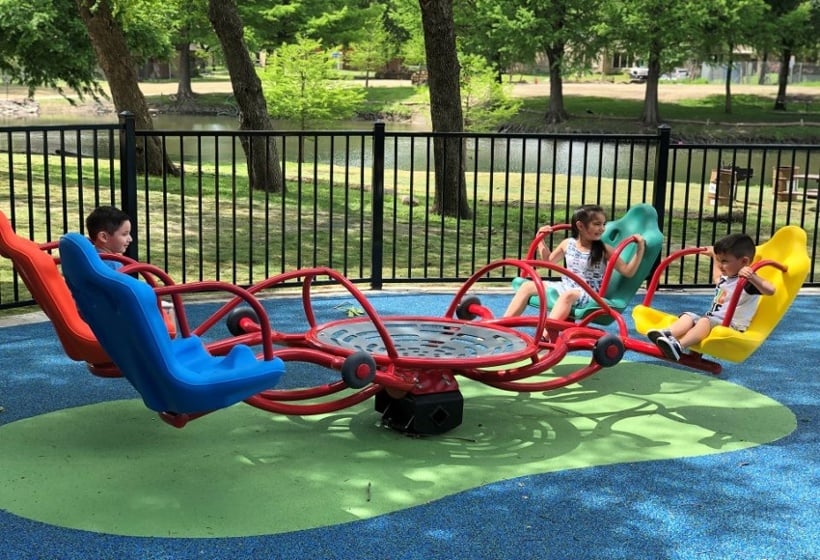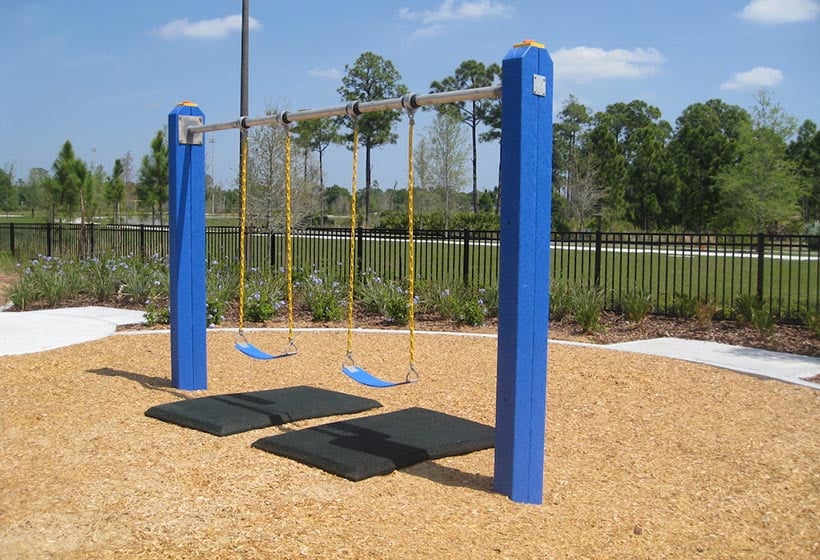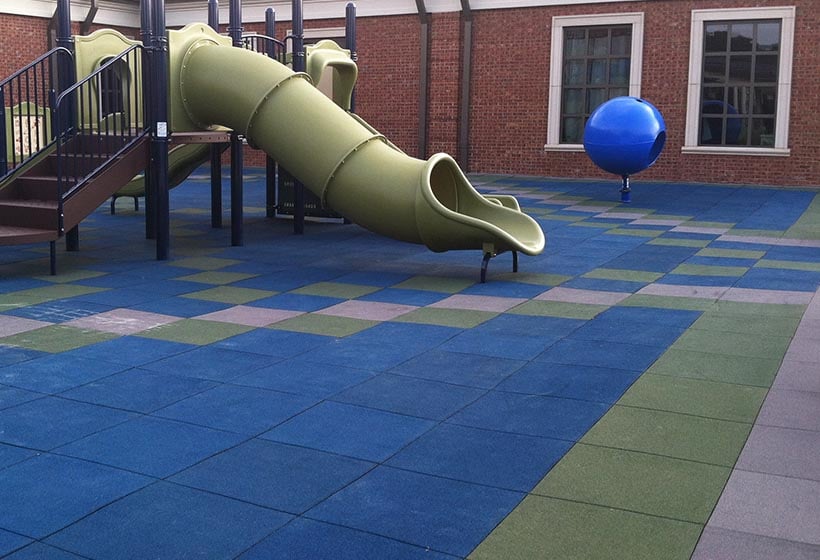When first reading the term “Inclusive Playground Design”, you might have some initial questions. “Don’t all playgrounds have to meet certain regulations to ensure safety for all children?” Yes, they do, but that is not exactly “inclusive.”
In the Americans with Disabilities Act, wheelchair accessibility is the only requirement listed under playgrounds. While necessary, this minimum requirement does not take into account children with social, sensory, or developmental disabilities. An inclusive playground provides a safe space for children to grow, collaborate, and play with one another in an environment that is sensory-rich and accessible to all children.
In a survey done by Landscape Structures, 57% of parents believe that all playgrounds require elements for children with down syndrome, processing disorders, visual impairments, and hearing impairments. The minimum requirements for playgrounds are not all-inclusive, but inclusive playground design fixes that issue.
What does an “Inclusive Playground” Involve?
Inclusive playgrounds are built on the belief that not only should there be something appealing to every child at the playground, but they should be encouraged to participate in activities with children different from themselves. This can be encouraged by the very structure of the playground.
There are 5 basic principles that go into building playgrounds for children. These principles include: Multi-sensory elements, accessibility, play for all, an opportunity for calm, and social environments.
Multi-Sensory Elements
All-inclusive playgrounds need to provide at least one element from each of the five principles. Multi-sensory elements are split into 5 senses, auditory, proprioceptive, tactile, vestibular, and visual.
Auditory stimulation is a key development feature because it teaches the brain how to interpret and differentiate different sounds. Playgrounds implement auditory stimulation through musical stations and talking tubes.
Proprioceptive stimulation includes the stretching and contracting of muscles and bending, straightening, pulling, and compressing of the joints. This is implemented by traditional playground equipment such as climbing walls, nets, ladders, and jumping stations.
Visual stimulation relies on appealing to the child’s sense of sight. This can be implemented in many ways, but the most popular are brightly colored play panels and contrasting colors.
Vestibular stimulation refers to the perception of the body in relation to gravity. This is most often implemented through stations that integrate movement and balance such as swings and spinners.
Tactile stimulation refers to the sense of touch. Playgrounds implement this through play panels and sand play. These varying textures trigger the perception of elements through a child’s skin and even their hair.
All five elements are essential to inclusive playground design. If a playground focused only on visual and auditory stimulation, the environment would be difficult for children with processing disorders to fully enjoy playing with their peers. Inclusive playgrounds are designed to appeal and benefit a wide array of children. By including all of the five sensory elements, every child can find a place to play.
Accessibility
All-inclusive playgrounds must be accessible. What is the point in building an inclusive playground, if it is difficult to get to, move across, or hazardous? The accessibility of a playground is essential. Accessibility has less to do with centralized locations or hours of operations, and much more to do with safety and comfort.
All playgrounds must meet ASTM 1292 surface material standards. Essentially, the ASTM standards deal with impact absorption in playground surfaces; all surfaces must pass the testing to be usable in playgrounds.
Aside from surfacing, playgrounds must have paths that are wide enough for wheelchair accessibility, strollers, and children who prefer not being touched when passing others. Flush transitions between stations and elevated areas are also important for children using mobility aids because it allows them to move freely throughout the park and surrounding areas.
Play for All
This idea refers to several stations that include different levels of engagement based on different developmental stages. Each station in the playground should have multiple levels of difficulty so every child has the opportunity to comfortably participate in the same activity. For example, a playground may have a climbing wall that is one station, but there are varying levels of difficulties based on which part of the wall a child is at. The left could include many handholds and footrests, while the one on the right might have fewer, making it more challenging. It is important to provide many different options so that every child has a choice and opportunity to engage with everything on the playground.
Social Environments
Playgrounds are an innately social environment. It is a public space where children of varying ages and developmental stages can come and play together. For many children, it is the first opportunity they get to learn how to appropriately engage with their peers. Taking this into account, cooperative play pieces are essential to developing and promoting these social skills.
The following are the four main types of play that help children cooperate and play together:
Associate play refers to children who play individually but mimic each other's actions or take turns. This is seen in pretend play and can happen during sand or water play. This encourages discourse among children and then provides them the opportunity to listen and implement what others are saying.
Onlooker play happens when one child is playing while another is watching or conversing without joining in. This provides the child watching to see how other children are playing and build up confidence so they can join when they feel comfortable.
Parallel play occurs when children are playing alongside one another and interacting with the child next to them. Each child engages in their own activity but is still interacting with others. This is most commonly seen on swings.
Solitary play happens when a child explores the playground on their own accord and chooses what they want to play with. This requires stations that only need one child to operate.
Opportunity for Calm
When considering all of these accessibility points, multi-sensory elements, and cooperative play types, it is easy for a child to become overstimulated. Every playground should have a place where a child can go to take a break, calm down, and return when they are ready. These structures also need to be in the park and within eyesight of the child’s caretakers. Playhouses are perfect for this because it makes the child feel like they are in an enclosed environment away from the overwhelming stimuli but still allows caretakers to keep an eye on them.
Conclusion
Playgrounds can be a place where children develop necessary social skills, motor skills, and memories that can last a lifetime. It is necessary to implement all of the aforementioned tools in a playground because it allows children of different developmental stages to interact with others. Having multi-sensory elements allows fair opportunity for children with auditory or visual disorders to engage their other senses.
Opportunity for calm allows children who become over-stimulated or have social disorders a chance to recharge and rejoin when they feel comfortable. Wide paths allow children with mobility disorders a chance to fully engage with the environment and allows children who don’t like being touched an opportunity to have their personal space. Every element on this list encourages collaboration and learning for all children involved. Inclusive playgrounds provide a safe space for all children to play and develop alongside their peers.
Looking to build an inclusive playground with optimal safety surfacing? Rubber Designs offers multiple options for playground surfacing from poured-in-place rubber to loose-fill rubber products. Learn more about our products, and contact us today.



